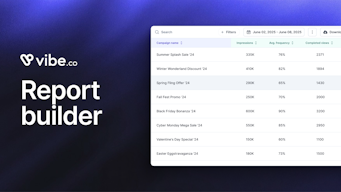Increase E-Commerce ROI with CTV
It should come as a surprise to exactly no one that e-commerce is the fastest growing sector in retail, gaining massive momentum during the pandemic but, most interestingly, maintaining that momentum for a few years now.
According to a recent industry report, e-commerce will account for 26% of global retail sales by the end of 2025, up from only 10% five years ago. In fact, the sector is expected to grow by almost $11 trillion between 2021 and 2025.
That’s great news for established brands looking to expand their digital footprint, but it also means it’s harder to stand out in a crowded field, especially as rising CPMs and signal loss plague digital advertisers.
Let’s look at some of the most significant challenges facing e-commerce today.
It’s a hard knock (digital) life
Don’t worry, we’ll get to solutions in a moment, but it is important to enter into the busiest quarter for e-commerce (Q4) sanguine and clear-eyed. So here’s the situation: digital video ad spending is higher than ever, but ROAS is dwindling as signal loss worsens, customer journeys fragment, and display CPMs increase. Let’s take a closer look at the reasons behind these shifts and what new tools might mitigate their effects.
Despite all of the digital doomsday talk you’ve probably heard, digital advertising spend isn’t going anywhere. In fact, it will grow exponentially over the next few years, especially in video.
In 2025, US digital video ad spend is expected to reach $67.16 billion, a nearly $12 billion increase over 2021. That’s more than double what it was in 2019, when US marketers spent $31.86 billion on video ads.
What is important now is to educate yourself and your team on the full spectrum of digital marketing options at your disposal.
Signal loss has led to plummeting ROAS
The most complicated challenge for advertisers to overcome right now is the overwhelming signal loss brought on by a dramatic increase in privacy regulations, most notably Apple’s ATT, Google 3rd party deprecation, and European GDPR guidelines. Because audiences are now harder to track, CPMs have gone up while ROAS continues to dwindle. Advertising across Facebook and Instagram, for example, has become much less effective, with Facebook ads already costing 47% more than last year, according to a recent eMarketer report.
Meanwhile, consumer’ buyers’ journeys are becoming more complex than ever: across all consumer categories spanning electronics to groceries, about 75 percent of US consumers are researching products and making purchases in both brick-and-mortar and online channels, frustrating marketers whose cross-device tracking options have taken a major blow.
According to the Video Ad Bureau, 65% of people who use a second screen while streaming look up products they see on TV. And we know that streaming viewers make purchases later on; 82% of DTC shoppers report taking action after seeing an ad for a DTC brand on CTV, according to data in Business Wire.
So what are some ways that e-commerce marketers facing increased costs and signal loss can work towards a successful end-of-year?
Implement full funnel, omni-channel campaigns
Don’t neglect brand awareness
While the threat of a potential economic downturn will push some advertisers to tighten their budgets and focus on performance channels almost exclusively, a recent Shopify study posits that long-term strategies focusing on customer lifetime value and brand loyalty will yield the best ROI.
That means brand awareness should absolutely be a part of your Q4 strategy, especially as consumers return from the Summer buying slump ready to discover new brands. Ultimately, the most successful strategy will include channels that offer both upper funnel brand building capabilities and trackable performance. Exploring CTV and OTT is a great way to capitalize on the storytelling power of television while maintaining the scale, viewability, and measurability of a performance campaign.
It’s time to innovate
As often happens in times of flux and uncertainty, innovation has been an exciting bedfellow to plummeting digital ROAS, but not enough e-commerce advertisers are taking advantage of ad tech innovation yet. Although E-commerce ad spending surged by nearly 50% last year, according to eMarketer, advertisers largely stuck to traditional digital channels like display and social, but as e-commerce continues to explode, marketers will need to push into every viable outlet.
Because you know who’s not afraid of innovation? Consumers. A recent McKinsey study showed that 70% of Americans tried new shopping channels during the pandemic, and that 44% of younger consumers experimented with new brands. Most importantly for advertisers still on the fence about branching out into new channels, of the shoppers who tried new brands in the past year and a half, 84% said they plan to stick with the new brand.
Experimenting with net-new channels like voice shopping, connected TV, and messaging apps can expand incremental reach in ways that advertisers could only dream of just a few years ago.
Let’s talk about CTV
One of the most exciting new channels to emerge in the last few years is CTV and its promise of big screen storytelling with the measurability of digital channels. Because CTV came of age during a time of regulatory upheaval for “legacy” digital channels, it was able to circumvent a lot of the targeting issues plaguing them today, as it focuses on household IP tracking, 1st party data integration, and real-time reporting.
Retailers are particularly well positioned (given their direct relationship with shoppers) to leverage the data that programmatic CTV DSPs like Vibe.co will need to target niche and emerging audiences and build a fully automated, repeatable, scalable methodology to identify activation opportunities.
With the right technology and identifying data, e-commerce brands can now track the immediate impact of CTV campaigns, and optimize them in near real time based on conversions taking place on devices linked to the household.
Examples and Best Practices
There are many ways to integrate CTV into an e-commerce campaign, depending on strategic goals, audience, business channels, and budget, but one thing is for sure: TV gets people’s limited attention and e-commerce marketers who wish to leverage the power of CTV need to understand how to break through the distraction of competing screens and reach consumers when they’re paying attention.
Large retailers are already integrating CTV into their strategies in powerful ways: Roku and Walmart, for example, recently entered into a partnership that will eventually allow Roku users to simply press “OK” with the remote on a shoppable ad and proceed to checkout with their payment details easily pre-populated from Roku Pay, to buy goods.
But the CTV market is still young and unsaturated, leaving plenty of opportunity for smaller operators. A simple and effective way to use streamed e-commerce video ads, for example, would be delivering customized messages to small audiences segmented by demographics and interests - a strategy that remains impossible on traditional linear television.
Here are three great examples of e-commerce CTV campaigns compiled by Digital Commerce 360:
- Cuisinart: Cuisinart chose to use clickable ads that would lead customers directly to their owned website, at which point they would be able to track customer journeys, even if they ended up purchasing a Cuisinart product from a retail partner, like Macy’s or Kohl’s. They also chose to refine their creative to meet audiences at every step of their buyer’s journey, with 30 second brand awareness ads for the top of the funnel, and performance-driven 15 second ads to close the deal. The result? In 2021, Cuisinart’s average order value for a CTV-related purchases averaged $229, compared to its overall website AOV of $40. Swish!
- Smile Direct Club: Because SmileDirectClub’s sales cycle typically takes 6 months to a year, their no.1 priority is to drive shoppers to its website to learn more about the brand’s teeth straightening aligners, says CMO, John Sheldon. SmileDirectClub has invested in CTV for shoppers who fall into the 18-34 age range and are thinking about teeth straightening. The main benefits to Smile Direct Club are real-time campaign results, education coupled with testimonial messages, and creating urgency through seasonal promotional activity around the New Year, for example. Today, nearly 10% of SmileDirectClub’s total ad spend goes toward CTV with plans to grow that budget line next year.
- Else Nutrition: Else Nutrition, which sells non-soy, plant-based formula for infants, toddlers and young children, launched a CTV campaign in March 2023 resulting in a 96.92% view through rate and 94% add to cart rate. Their marketing team was able to target their CTV ads by viewing moments, rather than by streaming source/channel alone. Viewing moments include time periods like during the morning news, live sports, late-night “insomnia” moments or while a person is binge-watching a program, CMO Barack Orenstein says. Else Nutrition planned to increase its $50,000 budget in 2024 four-fold to $200,000 in Q2.



